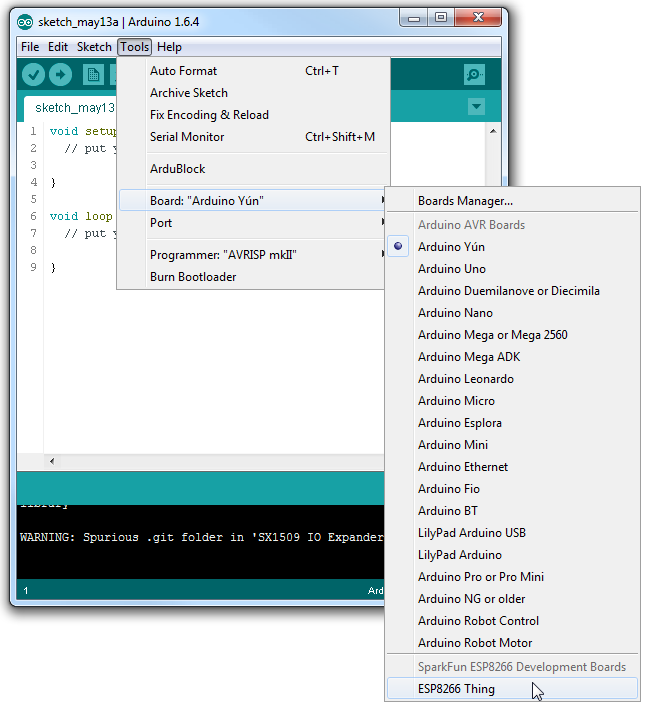Software Serial Esp8266 Lua Tutorial
Introduction: ESP8266 wifi module can be used as a development board with LUA programming. To start with LUA Programming on ESP8266 wifi module, the module should have a firm wire that supports LUA. NodeMCU is an open source firmware for ESP8266 wifi module. This tutorial explains how to upload NodeMCU firmware to ESP8266 wifi module. Before we go ahead you may need to know the setup connections of ESP8266, Connect RX and TX pins of ESP8266 module to the Serial Port of you computer, if you don't have one in your computer, FTDI or CP2102 can be used. Required Software Two software will be required to flash ESP8266 wifi module with NodeMCU. 2.1 NodeMCU Firmware Download NodeMCU firmware from the below link.
Esp8266 Lua Tutorial
You will find two firmware there, one is for integer and other is for float. Download any one of them as per your requirement. 2.2 Flasher A software will be required to transfer the firmware we downloaded in above step to the ESP8266 wifi module.
This software is known as flasher. Download flasher from the below mentioned link.
Esp8266 Serial Example
Don't forget to visit esp8266.com for the latest and greatest in ESP8266 news, software and gossip! Use a serial console program. Once you're back at the Lua. A series of IOT ESP8266 Tutorials. Part 1 IOT ESP8266 Tutorial – Using nodeMCU/LUA. Part 2 IOT ESP8266 Timer Tutorial – Arduino IDE. Part 3 IOT ESP8266 Tutorial – Using the Arduino IDE. Part 4 IOT ESP8266 Tutorial – AT Command Set Firmware. Part 5 IOT ESP8266 Tutorial – Connect to the IBM Bluemix Internet of Things.
It has got flasher for Win64 and Win32, download as per your computer's operating system. Flashing In order to flash ESP8266 wifi module, your module should be connected to your computer. From device manager of your computer please note down the comport no to which your ESP8266 wifi module is connected. For mine it is COM2. Open Flasher downloaded in above step and select COM Port.
Using Software serial on ESP8266 with Lua. Ask Question 0. I need to use ESP8266 standalone. LUA Programming,ESP8266 NODEMCU Serial communication-1. NodeMCU ESP8266 WiFi low RF power level. Programming ESP8266 NodeMCU Lua. Hot Network Questions. Software Engineering; Unix & Linux; Ask Different (Apple).
The steps to install windows XP are simple and easy. Windows xp sp4 free download. Comment here if you face any issues during windows XP ISO download or installation.
Click on configuration tab and enter the full path the firmware you downloaded in step2. If the path is correct it will be in green color else it will turn red. As shown in the following image. Go to Operation tab of Flasher software and click on Flash(F) button. Press Flash Switch (on ESP8266 Module) and reset the module by pressing reset switch.
You should keep on pressing Flash button while pressing and releasing Reset button. (Flash button connects GPIO0 to GND and Reset Button connects RST to GND) By doing this ESP8266 module will enter into flash mode, You may check this by clicking on Log tab of Flasher Software. It is showing Acknowledge successful. After successful acknowledgment it show the status of set base address. In the above image it is showing successful set base address. The module is being flashed with the NodeMCU firmware.
In the operation tab you can see current status of flashing. Once the module gets connected to Flasher software, it starts showing MAC address of the ESP8266 wifi module.
On successful completion of flashing green tick mark appear on bottom left corner. The same can be seen from Log tab of Flasher software.
Software Serial Esp8266 Lua Tutorial Download

After successful flashing Flasher software disconnects itself. The ESP8266 wifi module is now successfully flashed with NodeMCU firmware. You may use it for LUA programming. If you have any query please write us at our whatsapp helpline: +188 Thanks and Regards Content Development Team Robo India.
This tutorial is a step-by-step guide that shows you how to build a standalone ESP8266 Web Server that controls two outputs (two LEDs). This ESP8266 Web Server is mobile responsive and it can be accessed with any device that as a browser in your local network. If you want to learn more about the ESP8266 module, first read my.